Social Behavior and Culture: Examining Non-Human Primates and Culture
VerifiedAdded on 2020/04/21
|8
|1885
|78
Essay
AI Summary
This essay delves into the ongoing debate surrounding the existence of culture in non-human primates. It meticulously examines the social behaviors of various primate species, including communication methods like facial expressions, gestures, and grooming, as well as mate selection processes and social hierarchies. The essay also explores the use of tools among primates, such as chimpanzees and orangutans, and discusses the implications of these behaviors in relation to the evolution of human culture. By comparing the behavior of non-human primates with that of early human ancestors, the essay seeks to determine whether the social complexity and tool use observed in primates constitute evidence of cultural traits, ultimately concluding that while non-human primates demonstrate sophisticated social behavior, they have not yet attained culture.

Running head: DO NON-HUMAN PRIMATES HAVE CULTURE?
Do non-human primates have culture?
Name of the Student
Name of the University
Author’s Note
Do non-human primates have culture?
Name of the Student
Name of the University
Author’s Note
Paraphrase This Document
Need a fresh take? Get an instant paraphrase of this document with our AI Paraphraser
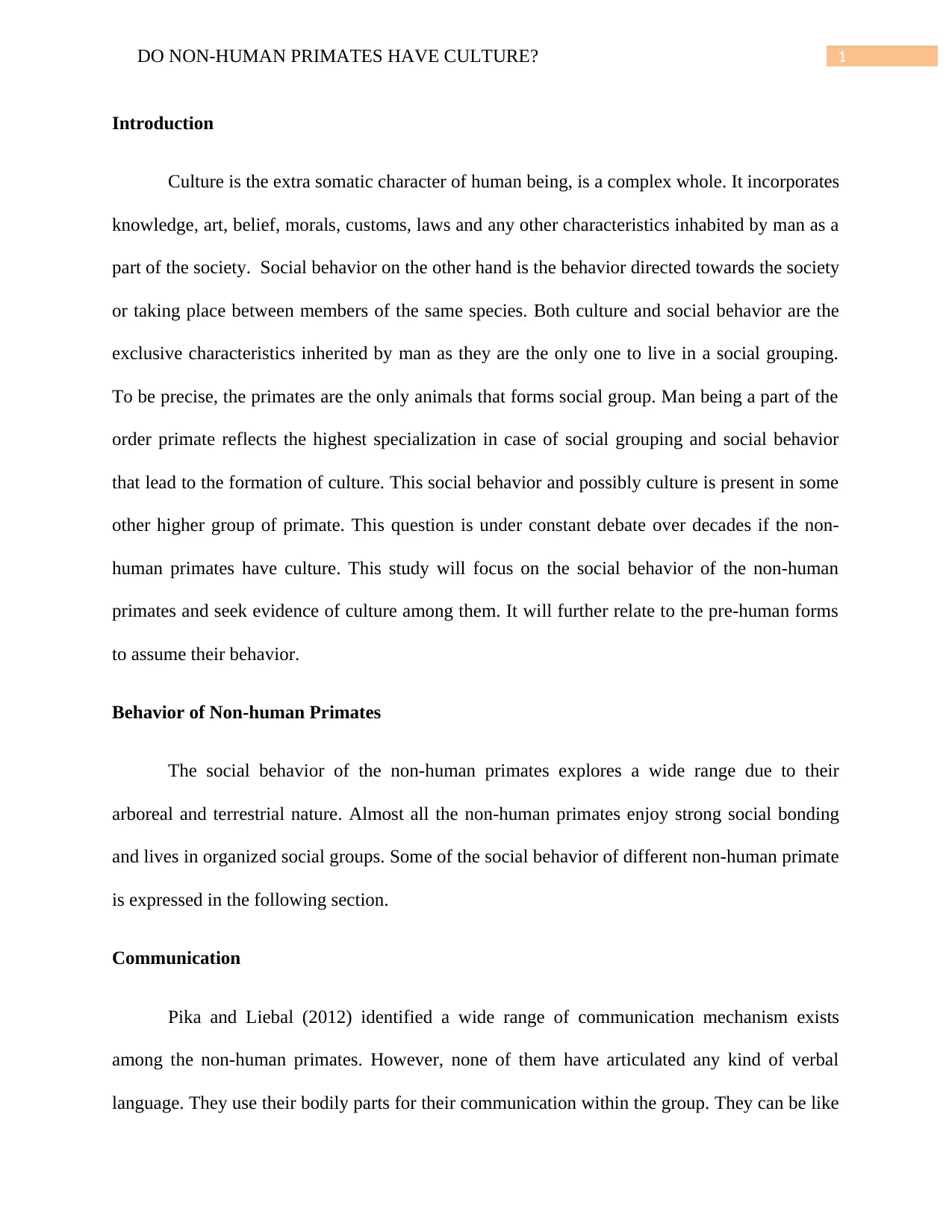
1DO NON-HUMAN PRIMATES HAVE CULTURE?
Introduction
Culture is the extra somatic character of human being, is a complex whole. It incorporates
knowledge, art, belief, morals, customs, laws and any other characteristics inhabited by man as a
part of the society. Social behavior on the other hand is the behavior directed towards the society
or taking place between members of the same species. Both culture and social behavior are the
exclusive characteristics inherited by man as they are the only one to live in a social grouping.
To be precise, the primates are the only animals that forms social group. Man being a part of the
order primate reflects the highest specialization in case of social grouping and social behavior
that lead to the formation of culture. This social behavior and possibly culture is present in some
other higher group of primate. This question is under constant debate over decades if the non-
human primates have culture. This study will focus on the social behavior of the non-human
primates and seek evidence of culture among them. It will further relate to the pre-human forms
to assume their behavior.
Behavior of Non-human Primates
The social behavior of the non-human primates explores a wide range due to their
arboreal and terrestrial nature. Almost all the non-human primates enjoy strong social bonding
and lives in organized social groups. Some of the social behavior of different non-human primate
is expressed in the following section.
Communication
Pika and Liebal (2012) identified a wide range of communication mechanism exists
among the non-human primates. However, none of them have articulated any kind of verbal
language. They use their bodily parts for their communication within the group. They can be like
Introduction
Culture is the extra somatic character of human being, is a complex whole. It incorporates
knowledge, art, belief, morals, customs, laws and any other characteristics inhabited by man as a
part of the society. Social behavior on the other hand is the behavior directed towards the society
or taking place between members of the same species. Both culture and social behavior are the
exclusive characteristics inherited by man as they are the only one to live in a social grouping.
To be precise, the primates are the only animals that forms social group. Man being a part of the
order primate reflects the highest specialization in case of social grouping and social behavior
that lead to the formation of culture. This social behavior and possibly culture is present in some
other higher group of primate. This question is under constant debate over decades if the non-
human primates have culture. This study will focus on the social behavior of the non-human
primates and seek evidence of culture among them. It will further relate to the pre-human forms
to assume their behavior.
Behavior of Non-human Primates
The social behavior of the non-human primates explores a wide range due to their
arboreal and terrestrial nature. Almost all the non-human primates enjoy strong social bonding
and lives in organized social groups. Some of the social behavior of different non-human primate
is expressed in the following section.
Communication
Pika and Liebal (2012) identified a wide range of communication mechanism exists
among the non-human primates. However, none of them have articulated any kind of verbal
language. They use their bodily parts for their communication within the group. They can be like
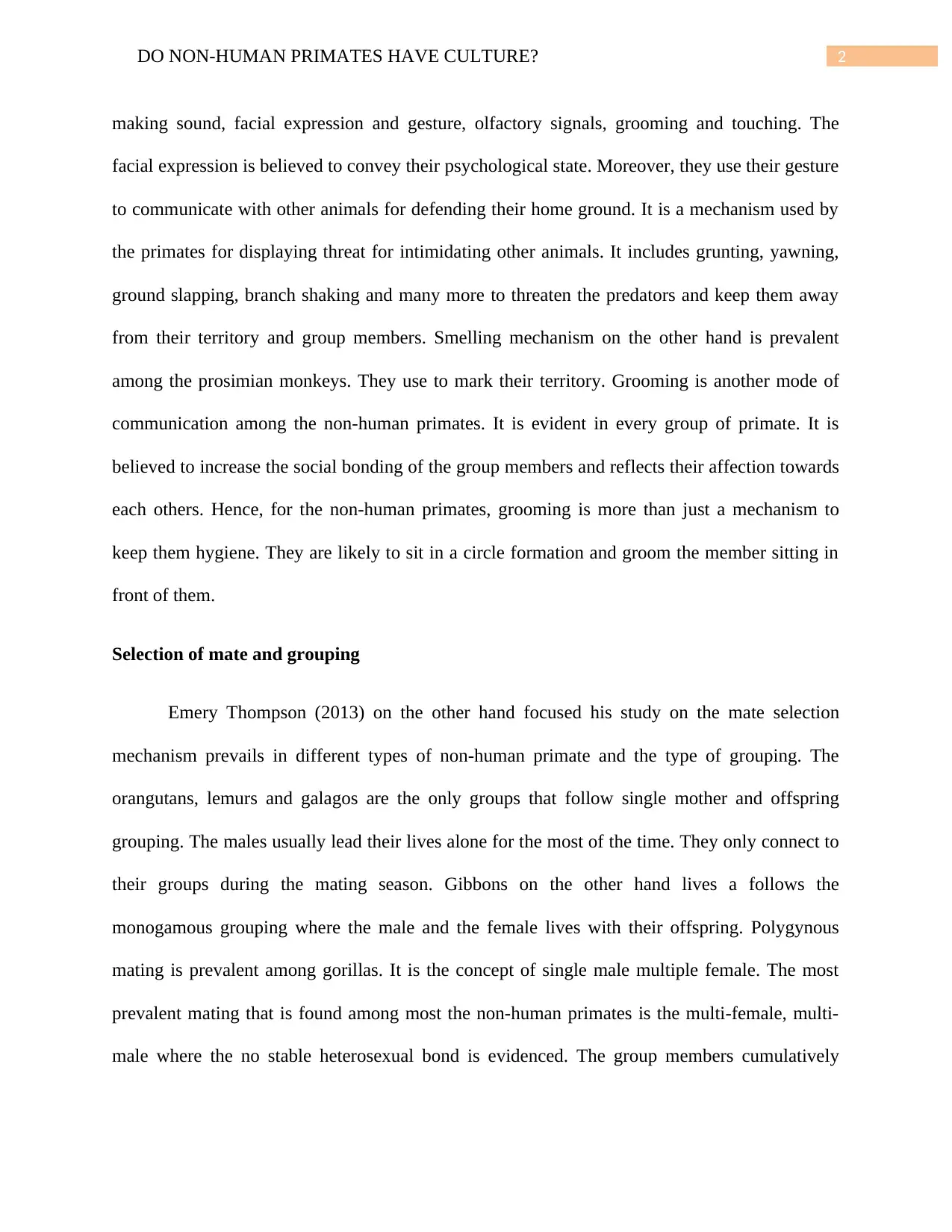
2DO NON-HUMAN PRIMATES HAVE CULTURE?
making sound, facial expression and gesture, olfactory signals, grooming and touching. The
facial expression is believed to convey their psychological state. Moreover, they use their gesture
to communicate with other animals for defending their home ground. It is a mechanism used by
the primates for displaying threat for intimidating other animals. It includes grunting, yawning,
ground slapping, branch shaking and many more to threaten the predators and keep them away
from their territory and group members. Smelling mechanism on the other hand is prevalent
among the prosimian monkeys. They use to mark their territory. Grooming is another mode of
communication among the non-human primates. It is evident in every group of primate. It is
believed to increase the social bonding of the group members and reflects their affection towards
each others. Hence, for the non-human primates, grooming is more than just a mechanism to
keep them hygiene. They are likely to sit in a circle formation and groom the member sitting in
front of them.
Selection of mate and grouping
Emery Thompson (2013) on the other hand focused his study on the mate selection
mechanism prevails in different types of non-human primate and the type of grouping. The
orangutans, lemurs and galagos are the only groups that follow single mother and offspring
grouping. The males usually lead their lives alone for the most of the time. They only connect to
their groups during the mating season. Gibbons on the other hand lives a follows the
monogamous grouping where the male and the female lives with their offspring. Polygynous
mating is prevalent among gorillas. It is the concept of single male multiple female. The most
prevalent mating that is found among most the non-human primates is the multi-female, multi-
male where the no stable heterosexual bond is evidenced. The group members cumulatively
making sound, facial expression and gesture, olfactory signals, grooming and touching. The
facial expression is believed to convey their psychological state. Moreover, they use their gesture
to communicate with other animals for defending their home ground. It is a mechanism used by
the primates for displaying threat for intimidating other animals. It includes grunting, yawning,
ground slapping, branch shaking and many more to threaten the predators and keep them away
from their territory and group members. Smelling mechanism on the other hand is prevalent
among the prosimian monkeys. They use to mark their territory. Grooming is another mode of
communication among the non-human primates. It is evident in every group of primate. It is
believed to increase the social bonding of the group members and reflects their affection towards
each others. Hence, for the non-human primates, grooming is more than just a mechanism to
keep them hygiene. They are likely to sit in a circle formation and groom the member sitting in
front of them.
Selection of mate and grouping
Emery Thompson (2013) on the other hand focused his study on the mate selection
mechanism prevails in different types of non-human primate and the type of grouping. The
orangutans, lemurs and galagos are the only groups that follow single mother and offspring
grouping. The males usually lead their lives alone for the most of the time. They only connect to
their groups during the mating season. Gibbons on the other hand lives a follows the
monogamous grouping where the male and the female lives with their offspring. Polygynous
mating is prevalent among gorillas. It is the concept of single male multiple female. The most
prevalent mating that is found among most the non-human primates is the multi-female, multi-
male where the no stable heterosexual bond is evidenced. The group members cumulatively
⊘ This is a preview!⊘
Do you want full access?
Subscribe today to unlock all pages.

Trusted by 1+ million students worldwide
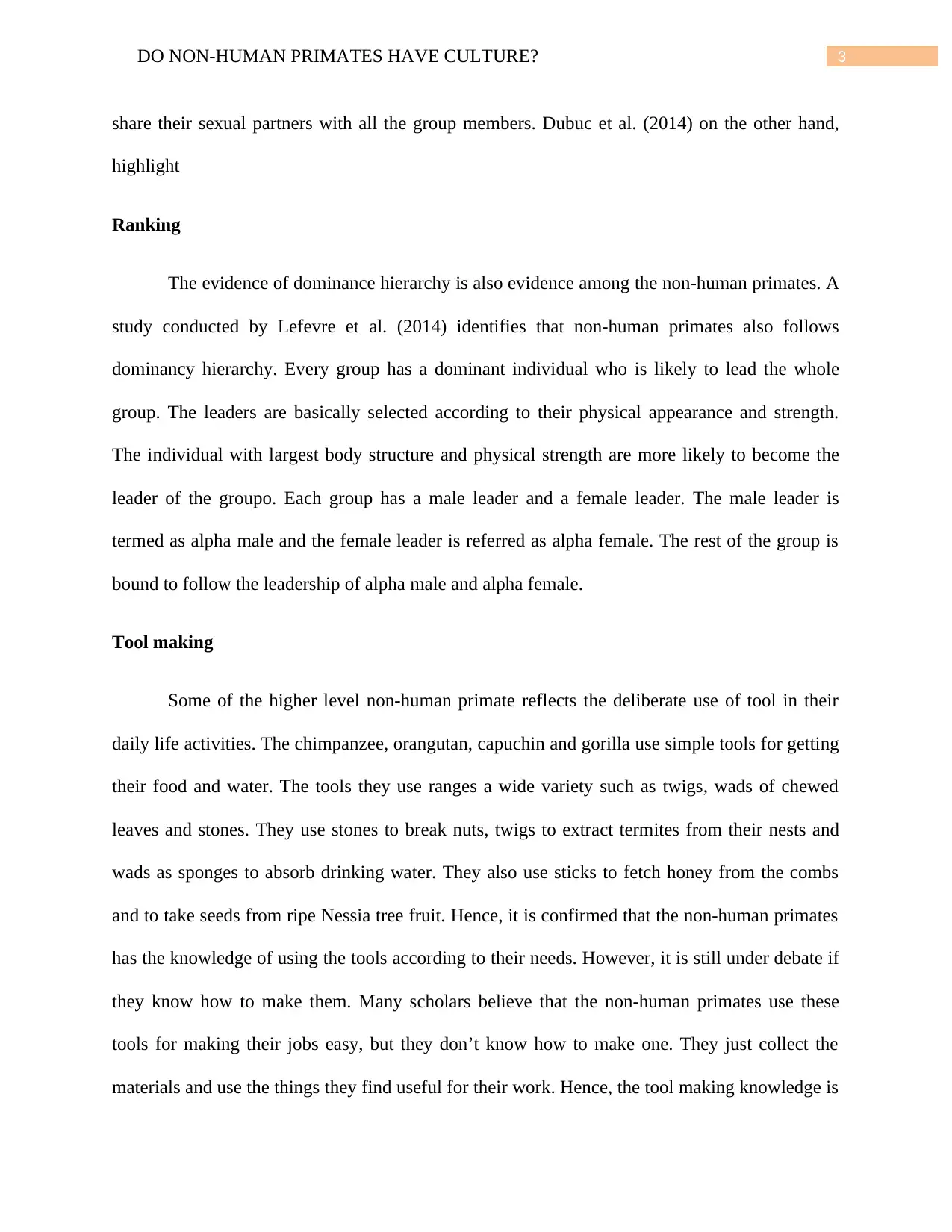
3DO NON-HUMAN PRIMATES HAVE CULTURE?
share their sexual partners with all the group members. Dubuc et al. (2014) on the other hand,
highlight
Ranking
The evidence of dominance hierarchy is also evidence among the non-human primates. A
study conducted by Lefevre et al. (2014) identifies that non-human primates also follows
dominancy hierarchy. Every group has a dominant individual who is likely to lead the whole
group. The leaders are basically selected according to their physical appearance and strength.
The individual with largest body structure and physical strength are more likely to become the
leader of the groupo. Each group has a male leader and a female leader. The male leader is
termed as alpha male and the female leader is referred as alpha female. The rest of the group is
bound to follow the leadership of alpha male and alpha female.
Tool making
Some of the higher level non-human primate reflects the deliberate use of tool in their
daily life activities. The chimpanzee, orangutan, capuchin and gorilla use simple tools for getting
their food and water. The tools they use ranges a wide variety such as twigs, wads of chewed
leaves and stones. They use stones to break nuts, twigs to extract termites from their nests and
wads as sponges to absorb drinking water. They also use sticks to fetch honey from the combs
and to take seeds from ripe Nessia tree fruit. Hence, it is confirmed that the non-human primates
has the knowledge of using the tools according to their needs. However, it is still under debate if
they know how to make them. Many scholars believe that the non-human primates use these
tools for making their jobs easy, but they don’t know how to make one. They just collect the
materials and use the things they find useful for their work. Hence, the tool making knowledge is
share their sexual partners with all the group members. Dubuc et al. (2014) on the other hand,
highlight
Ranking
The evidence of dominance hierarchy is also evidence among the non-human primates. A
study conducted by Lefevre et al. (2014) identifies that non-human primates also follows
dominancy hierarchy. Every group has a dominant individual who is likely to lead the whole
group. The leaders are basically selected according to their physical appearance and strength.
The individual with largest body structure and physical strength are more likely to become the
leader of the groupo. Each group has a male leader and a female leader. The male leader is
termed as alpha male and the female leader is referred as alpha female. The rest of the group is
bound to follow the leadership of alpha male and alpha female.
Tool making
Some of the higher level non-human primate reflects the deliberate use of tool in their
daily life activities. The chimpanzee, orangutan, capuchin and gorilla use simple tools for getting
their food and water. The tools they use ranges a wide variety such as twigs, wads of chewed
leaves and stones. They use stones to break nuts, twigs to extract termites from their nests and
wads as sponges to absorb drinking water. They also use sticks to fetch honey from the combs
and to take seeds from ripe Nessia tree fruit. Hence, it is confirmed that the non-human primates
has the knowledge of using the tools according to their needs. However, it is still under debate if
they know how to make them. Many scholars believe that the non-human primates use these
tools for making their jobs easy, but they don’t know how to make one. They just collect the
materials and use the things they find useful for their work. Hence, the tool making knowledge is
Paraphrase This Document
Need a fresh take? Get an instant paraphrase of this document with our AI Paraphraser
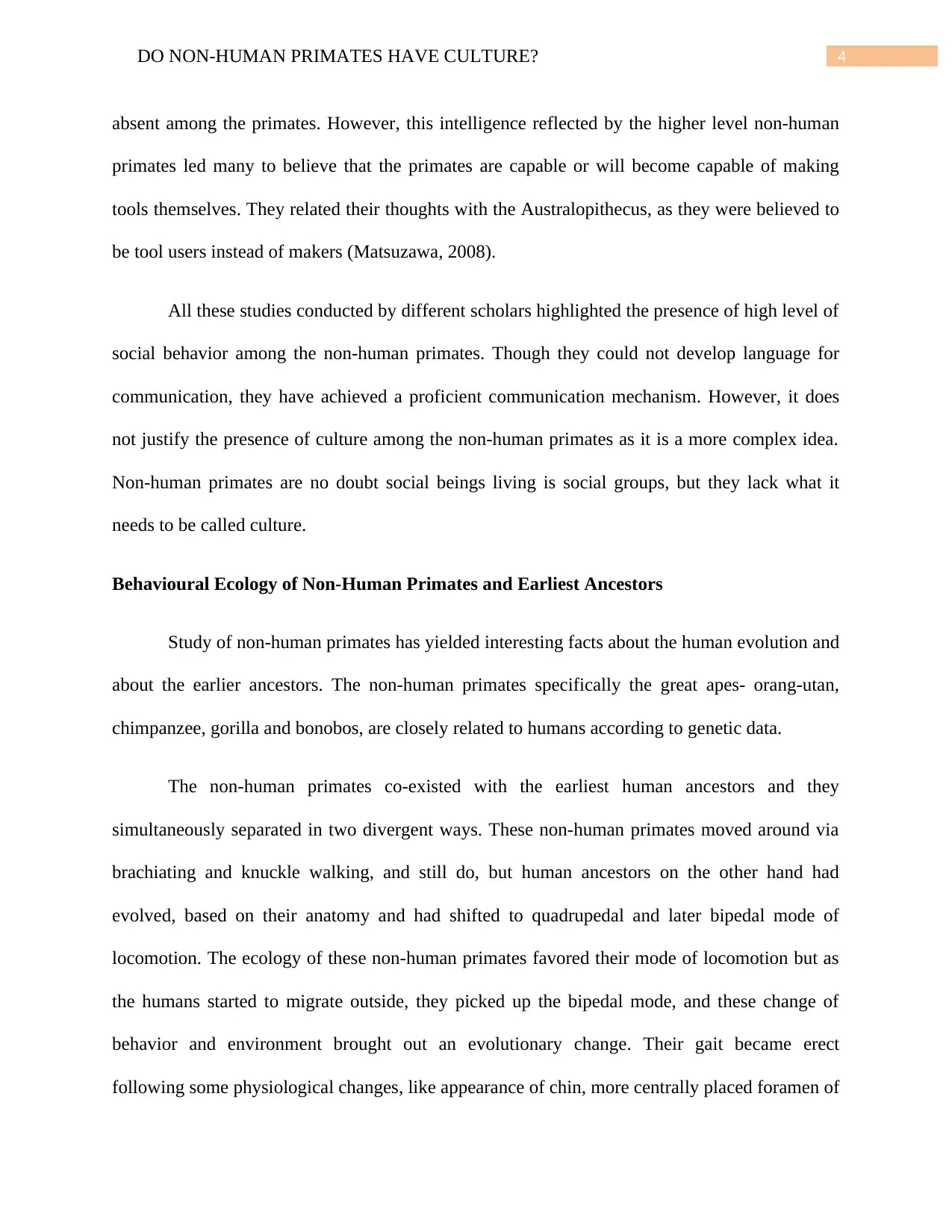
4DO NON-HUMAN PRIMATES HAVE CULTURE?
absent among the primates. However, this intelligence reflected by the higher level non-human
primates led many to believe that the primates are capable or will become capable of making
tools themselves. They related their thoughts with the Australopithecus, as they were believed to
be tool users instead of makers (Matsuzawa, 2008).
All these studies conducted by different scholars highlighted the presence of high level of
social behavior among the non-human primates. Though they could not develop language for
communication, they have achieved a proficient communication mechanism. However, it does
not justify the presence of culture among the non-human primates as it is a more complex idea.
Non-human primates are no doubt social beings living is social groups, but they lack what it
needs to be called culture.
Behavioural Ecology of Non-Human Primates and Earliest Ancestors
Study of non-human primates has yielded interesting facts about the human evolution and
about the earlier ancestors. The non-human primates specifically the great apes- orang-utan,
chimpanzee, gorilla and bonobos, are closely related to humans according to genetic data.
The non-human primates co-existed with the earliest human ancestors and they
simultaneously separated in two divergent ways. These non-human primates moved around via
brachiating and knuckle walking, and still do, but human ancestors on the other hand had
evolved, based on their anatomy and had shifted to quadrupedal and later bipedal mode of
locomotion. The ecology of these non-human primates favored their mode of locomotion but as
the humans started to migrate outside, they picked up the bipedal mode, and these change of
behavior and environment brought out an evolutionary change. Their gait became erect
following some physiological changes, like appearance of chin, more centrally placed foramen of
absent among the primates. However, this intelligence reflected by the higher level non-human
primates led many to believe that the primates are capable or will become capable of making
tools themselves. They related their thoughts with the Australopithecus, as they were believed to
be tool users instead of makers (Matsuzawa, 2008).
All these studies conducted by different scholars highlighted the presence of high level of
social behavior among the non-human primates. Though they could not develop language for
communication, they have achieved a proficient communication mechanism. However, it does
not justify the presence of culture among the non-human primates as it is a more complex idea.
Non-human primates are no doubt social beings living is social groups, but they lack what it
needs to be called culture.
Behavioural Ecology of Non-Human Primates and Earliest Ancestors
Study of non-human primates has yielded interesting facts about the human evolution and
about the earlier ancestors. The non-human primates specifically the great apes- orang-utan,
chimpanzee, gorilla and bonobos, are closely related to humans according to genetic data.
The non-human primates co-existed with the earliest human ancestors and they
simultaneously separated in two divergent ways. These non-human primates moved around via
brachiating and knuckle walking, and still do, but human ancestors on the other hand had
evolved, based on their anatomy and had shifted to quadrupedal and later bipedal mode of
locomotion. The ecology of these non-human primates favored their mode of locomotion but as
the humans started to migrate outside, they picked up the bipedal mode, and these change of
behavior and environment brought out an evolutionary change. Their gait became erect
following some physiological changes, like appearance of chin, more centrally placed foramen of
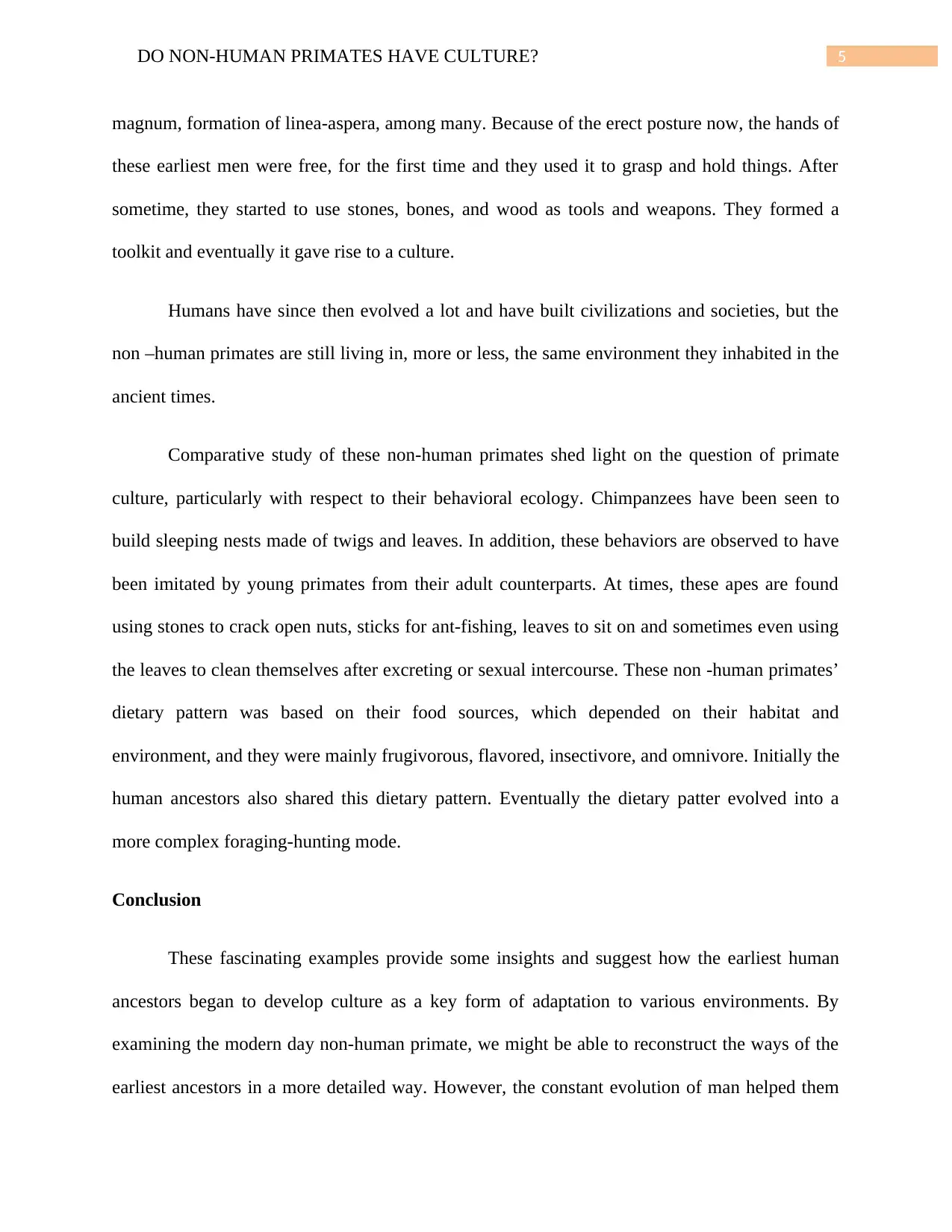
5DO NON-HUMAN PRIMATES HAVE CULTURE?
magnum, formation of linea-aspera, among many. Because of the erect posture now, the hands of
these earliest men were free, for the first time and they used it to grasp and hold things. After
sometime, they started to use stones, bones, and wood as tools and weapons. They formed a
toolkit and eventually it gave rise to a culture.
Humans have since then evolved a lot and have built civilizations and societies, but the
non –human primates are still living in, more or less, the same environment they inhabited in the
ancient times.
Comparative study of these non-human primates shed light on the question of primate
culture, particularly with respect to their behavioral ecology. Chimpanzees have been seen to
build sleeping nests made of twigs and leaves. In addition, these behaviors are observed to have
been imitated by young primates from their adult counterparts. At times, these apes are found
using stones to crack open nuts, sticks for ant-fishing, leaves to sit on and sometimes even using
the leaves to clean themselves after excreting or sexual intercourse. These non -human primates’
dietary pattern was based on their food sources, which depended on their habitat and
environment, and they were mainly frugivorous, flavored, insectivore, and omnivore. Initially the
human ancestors also shared this dietary pattern. Eventually the dietary patter evolved into a
more complex foraging-hunting mode.
Conclusion
These fascinating examples provide some insights and suggest how the earliest human
ancestors began to develop culture as a key form of adaptation to various environments. By
examining the modern day non-human primate, we might be able to reconstruct the ways of the
earliest ancestors in a more detailed way. However, the constant evolution of man helped them
magnum, formation of linea-aspera, among many. Because of the erect posture now, the hands of
these earliest men were free, for the first time and they used it to grasp and hold things. After
sometime, they started to use stones, bones, and wood as tools and weapons. They formed a
toolkit and eventually it gave rise to a culture.
Humans have since then evolved a lot and have built civilizations and societies, but the
non –human primates are still living in, more or less, the same environment they inhabited in the
ancient times.
Comparative study of these non-human primates shed light on the question of primate
culture, particularly with respect to their behavioral ecology. Chimpanzees have been seen to
build sleeping nests made of twigs and leaves. In addition, these behaviors are observed to have
been imitated by young primates from their adult counterparts. At times, these apes are found
using stones to crack open nuts, sticks for ant-fishing, leaves to sit on and sometimes even using
the leaves to clean themselves after excreting or sexual intercourse. These non -human primates’
dietary pattern was based on their food sources, which depended on their habitat and
environment, and they were mainly frugivorous, flavored, insectivore, and omnivore. Initially the
human ancestors also shared this dietary pattern. Eventually the dietary patter evolved into a
more complex foraging-hunting mode.
Conclusion
These fascinating examples provide some insights and suggest how the earliest human
ancestors began to develop culture as a key form of adaptation to various environments. By
examining the modern day non-human primate, we might be able to reconstruct the ways of the
earliest ancestors in a more detailed way. However, the constant evolution of man helped them
⊘ This is a preview!⊘
Do you want full access?
Subscribe today to unlock all pages.

Trusted by 1+ million students worldwide

6DO NON-HUMAN PRIMATES HAVE CULTURE?
achieve culture where the other primate lacks. Hence, the non-human primates are in a stage of
evolution that distinguish human and early hominids from other primates. The non-human
primates may or may not further evolve to some stage where they might attain culture, but
currently they are have not yet attain culture, despite of demonstration of social behavior.
achieve culture where the other primate lacks. Hence, the non-human primates are in a stage of
evolution that distinguish human and early hominids from other primates. The non-human
primates may or may not further evolve to some stage where they might attain culture, but
currently they are have not yet attain culture, despite of demonstration of social behavior.
Paraphrase This Document
Need a fresh take? Get an instant paraphrase of this document with our AI Paraphraser
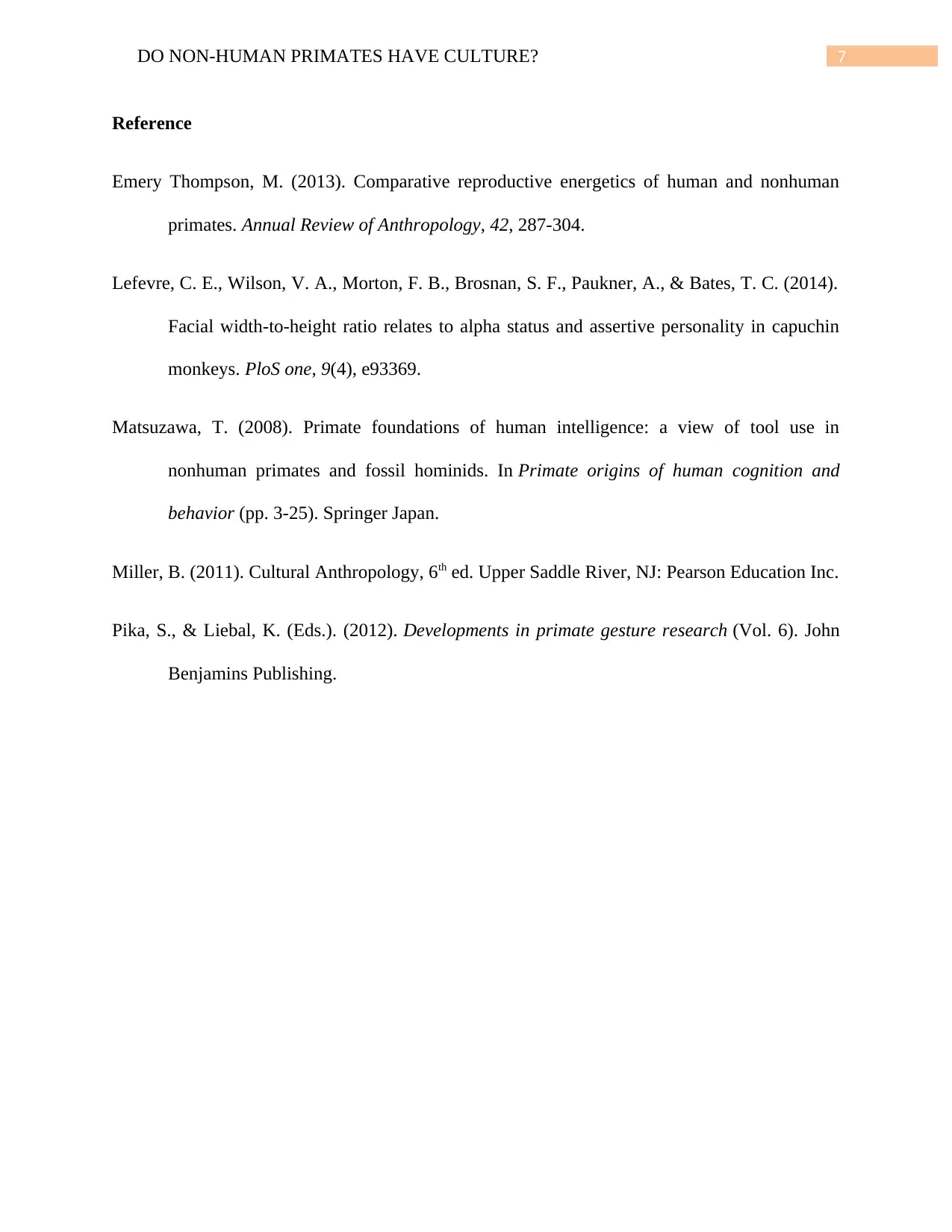
7DO NON-HUMAN PRIMATES HAVE CULTURE?
Reference
Emery Thompson, M. (2013). Comparative reproductive energetics of human and nonhuman
primates. Annual Review of Anthropology, 42, 287-304.
Lefevre, C. E., Wilson, V. A., Morton, F. B., Brosnan, S. F., Paukner, A., & Bates, T. C. (2014).
Facial width-to-height ratio relates to alpha status and assertive personality in capuchin
monkeys. PloS one, 9(4), e93369.
Matsuzawa, T. (2008). Primate foundations of human intelligence: a view of tool use in
nonhuman primates and fossil hominids. In Primate origins of human cognition and
behavior (pp. 3-25). Springer Japan.
Miller, B. (2011). Cultural Anthropology, 6th ed. Upper Saddle River, NJ: Pearson Education Inc.
Pika, S., & Liebal, K. (Eds.). (2012). Developments in primate gesture research (Vol. 6). John
Benjamins Publishing.
Reference
Emery Thompson, M. (2013). Comparative reproductive energetics of human and nonhuman
primates. Annual Review of Anthropology, 42, 287-304.
Lefevre, C. E., Wilson, V. A., Morton, F. B., Brosnan, S. F., Paukner, A., & Bates, T. C. (2014).
Facial width-to-height ratio relates to alpha status and assertive personality in capuchin
monkeys. PloS one, 9(4), e93369.
Matsuzawa, T. (2008). Primate foundations of human intelligence: a view of tool use in
nonhuman primates and fossil hominids. In Primate origins of human cognition and
behavior (pp. 3-25). Springer Japan.
Miller, B. (2011). Cultural Anthropology, 6th ed. Upper Saddle River, NJ: Pearson Education Inc.
Pika, S., & Liebal, K. (Eds.). (2012). Developments in primate gesture research (Vol. 6). John
Benjamins Publishing.
1 out of 8
Related Documents
Your All-in-One AI-Powered Toolkit for Academic Success.
+13062052269
info@desklib.com
Available 24*7 on WhatsApp / Email
![[object Object]](/_next/static/media/star-bottom.7253800d.svg)
Unlock your academic potential
Copyright © 2020–2025 A2Z Services. All Rights Reserved. Developed and managed by ZUCOL.





